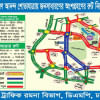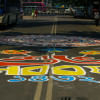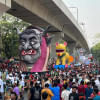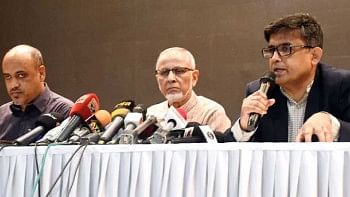Welcoming Bangla New Year 1432 in the spirit of ‘Swadesh’

As the first light of dawn touched Dhanmondi's Rabindra Sarobar, the soft strains of the Sarod filled the air, mingling with birdsong and the soulful echoes of "Alo Amar Alo."
With that began the Ispahani Channel i 'Shurer Dhara' celebration of Pahela Baishakh 1432—a vibrant homage to the spirit of Swadesh, the soul of the homeland.
The programme commenced at 6:00am with a performance by artists from Bengal Parampara Sangeetalay. Soon after, the stage was taken over by the soulful renditions of the 'Panchakabi'—Rabindranath Tagore, Kazi Nazrul Islam, Dwijendralal Roy, Rajanikanta Sen, and Atul Prasad Sen—performed by singers of Shurer Dhara. The event opened with Tagore's "Alo Amar Alo," followed by Nazrul's "Probhat Bina Tobo Baaje Hey," which seemed to call in the morning with poetic grace.
One of the most captivating segments of the celebration was the participation of indigenous artists from different ethnic communities. Dressed in traditional attire, performers from the Chittagong Hill Tracts, Mymensingh, and northern regions of Bangladesh presented their folk songs and dances, adding rich cultural diversity to the theme of national unity.
Later, artists from indigenous communities of the Chittagong Hill Tracts performed the song "Amader Desh Heera-Manik, Shona, Rupay Bhora" in their regional languages.
Crowds poured in from various corners of the city—Mirpur, Uttara, and Old Dhaka among them. Families, artists, and culture enthusiasts thronged the venue from early morning, many of them regular attendees who consider this celebration an annual ritual.
The festival grounds also featured a traditional fair, complete with rural games and stalls showcasing clay dolls, jute crafts, handmade items, and indigenous cottage industry products. It was a celebration of local craftsmanship as much as music and art.
Adding further colour to the event was a special art camp where renowned musicians, dancers, and painters came together to create artwork inspired by themes of the New Year and Swadesh. Children and teenagers also joined in, turning the Sarobar into a vibrant intergenerational space of creativity.
With over 300 performers contributing to the festivities, the Rabindra Sarobar transformed into a grand cultural celebration—a harmonious blend of music, art, and community to usher in the Bengali New Year with heart and soul.
The Pahela Baishakh celebration, jointly organised by Channel i and Shurer Dhara, was supported by the Ministry of Cultural Affairs and Dhaka South City Corporation.

 For all latest news, follow The Daily Star's Google News channel.
For all latest news, follow The Daily Star's Google News channel. 








Comments